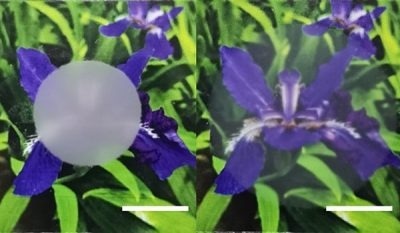Current technologies transform materials from dark to light or cold to hot simply by blocking or transmitting specific wavelengths. Scientists have reported a soft film that can change its transparency across various wavelengths—visible, infrared, and microwave—concurrently, inspired by squid skin.
 Compressing this soft material blocks a wide range of wavelengths, including visible light (left), and stretching it out lets them through (right). Image Credit: Adapted from ACS Nano 2023.
Compressing this soft material blocks a wide range of wavelengths, including visible light (left), and stretching it out lets them through (right). Image Credit: Adapted from ACS Nano 2023.
They used the material in smart windows and health monitoring and temperature control applications. The study was published in the journal ACS Nano.
Iridocytes and chromatophores, specific to the skin of squid and other cephalopods, change direction and vary the animals’ appearance. Likewise, scientists have created synthetic materials that change from reflecting to transmitting visible and infrared wavelengths by changing from wrinkly to cracked.
Microwaves are unaffected since they are far more significant than these surface structures. Researchers recently discovered, however, that thick networks of electrically conductive materials, such as silver nanowires, can block microwaves.
So, Yi Yang, Guangbin Ji, Zhichuan J. Xu, and colleagues aimed to combine surface features with a conductive network in a soft film that could rapidly switch between blocking visible-to-microwave bands and allowing them through.
The researchers generated a two-layer film by spraying a thin layer of silver nanowires over a stretched elastomer. Stretching and contracting the material resulted in fissures and rough wrinkles on the metal surface. The material then blocked light, trapped infrared heat, and protected up to 99.9% of microwaves that could interfere with gadgets when the researchers contracted it to a -30% strain. And when the material stretched apart, the increase in optical transparency, heat, and microwaves transmitted was precisely proportional to the expansion. Furthermore, the researchers illustrated how the material may be used in a variety of applications:
- To send or receive wireless electrocardiography signals
- As a blanket to either trap or allow body heat to escape
- Since the materials produce temperature fluctuations that infrared cameras can detect, they are useful for detecting movements
The ability of their system to change its transparency repeatedly and swiftly, according to the researchers, might assist dynamic camouflage technologies, energy-efficient structures, and adaptive personal and healthcare devices.
The National Nature Science Foundation of China and the National Science and Technology Major Project of China funded the study.
Journal Reference:
Liang, L., et al. (2023). An Adaptive Multispectral Mechano-Optical System for Multipurpose Applications. ACS Nano. doi.org/10.1021/acsnano.3c01836.